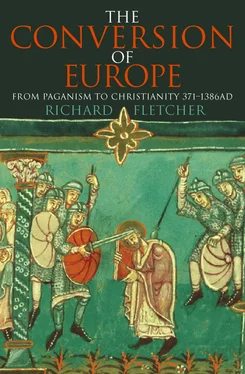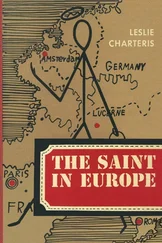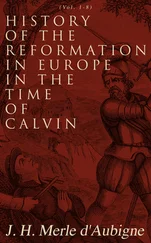In 1824 Moshoeshoe had established a new royal settlement at Thaba Bosiu, an isolated tableland protected by cliffs which rose above the upper waters of the river Caledon some hundred miles above its confluence with the Orange river. It was there that three members of the Paris Société approached him in 1833, and at the foot of this natural fortress that they established their first mission station. It was a proximity that echoes the close spatial association of royalty and mission so often found in early medieval Europe. Thus in 635 St Aidan would establish his monastic mission station at Lindisfarne, within sight of the royal rock-fortress of Bamburgh. Moshoeshoe had wanted the missionaries to come to his kingdom for reasons that arose from the Zulu Faqane . Its effects of destabilization and demoralization had led him, a thoughtful man (as Bede presents Edwin), to wonder about the efficacy of his traditional religious observances. How could the ancestors and spirits have let these things occur? – if they really were as powerful as he had been taught to believe. Second, the Faqane had pushed his people into closer proximity to the white man. The British government at the Cape was a long way off but the Afrikaners were close at hand, some of them even beginning to cross to the northern side of the Orange river in search of new pastures for their flocks. The missionaries were outsiders, neutrals. They might help Moshoeshoe to cope with this unfamiliar world which threatened to encroach upon his people. They were baruti , teachers, who might initiate him into the secrets of the white man’s power.
Circumstances were such, therefore, that a friendly rapport was established between king and missionaries at the outset. With one of the three in particular, Eugène Casalis, Moshoeshoe struck up a warm friendship. The king showed a keen interest in Christianity. He would discuss the faith for hours on end with Casalis, encouraged his people to listen to the missionaries’ teaching, and put no obstacles in the path of individual converts. Every Sunday Moshoeshoe would don European clothes and descend from Thaba Bosiu to attend divine service at the mission chapel which had been built by workmen supplied by him free of charge. At the end of the sermon he would add his own comments on it for the edification of the congregation. One of the missionaries recorded that these royal glosses ‘often conveyed the essence of what they had been saying in words that made it more intelligible to the rest of the congregation without distorting it’. After church the king would dine with Casalis and his Scottish wife at the mission house.
Clothes and dinners were not the only trappings of Christian civilization which appealed to Moshoeshoe. He developed a taste for European horses, saddlery, wagons, firearms, agricultural implements and household utensils. He employed a deserter from the British army to build him a house of stone. Another mason whom he employed, Josias Hoffmann, later became the first president (1854–5) of the Orange Free State. He planted wheat, fruit trees and vegetables under missionary guidance. He had the greatest respect for literacy, but though he struggled hard he never quite mastered the art of writing. He adopted the European habit of issuing written laws ‘with the advice and concurrence of the great men of our tribe’: these edicts were printed in the Sesotho vernacular on a missionary printing press.
The presence and skills of the missionaries enhanced Moshoeshoe’s prestige. Under his rule the kingdom found stability and began to enjoy prosperity. The king was convinced that this was the fruit of Christianity. ‘It is the Gospel that is the source of the prosperity and peace which you enjoy,’ he told his subjects in 1842. Trade prospered under royal encouragement, regulated in one of Moshoeshoe’s written ordinances. Coin began to replace barter as a means of exchange. Casalis and his colleagues encouraged the peaceful consolidation and expansion of Moshoeshoe’s power: both parties profited from it. The string of mission stations gradually founded as offspring of the original at Thaba Bosiu was rightly perceived as useful by the king. They helped to encourage peaceful nucleated settlement; they assisted to consolidate the royal hold upon new territory; they performed a defensive function for local people and livestock in troubled times. As for the outside world, Casalis acted as a kind of secretary for foreign affairs to Moshoeshoe. Surviving diplomatic correspondence is in Casalis’s hand, subscribed by the king with a cross. Everything looked as if it were going the missionaries’ way.
Casalis and his colleagues made many converts in Lesotho. But the king, finally and after much anxious hesitation, was not among them. In deference to missionary teaching Moshoeshoe decreed changes in some of the most intimate areas of Sotho life, affecting marriage customs, initiation rituals, resort to witches and burial practices. Some of these initiatives provoked opposition. Moshoeshoe had to restore the traditional initiation rituals in all their gruesomeness, and his attempts to change marriage customs met with resentment and resistance. One of the leaders of the opposition was Tsapi, Moshoeshoe’s chief diviner, a man respected and feared for his power to foretell the future and to communicate with the spirit world. In 1839 there was an epidemic of measles. Moshoeshoe’s ancestors appeared to Tsapi and told him that ‘the children of Thaba Bosiu die because Moshoeshoe is polluted and because the evening prayers offend the ancestral spirits’. The king’s son Molapo accepted Christianity and was baptized, but apostasized a few years later. Even though three of Moshoeshoe’s wives and two of his leading counsellors became Christians, there was strong opposition at court. Moshoeshoe realized that to commit himself to Christianity would be to split his kingdom. So he never did.
There is much for the early medievalist to ponder in the story of the coming of Christianity to Lesotho. How much more we might learn could we but eavesdrop on some heavenly conversation between Casalis and Augustine, or Moshoeshoe and Ethelbert. Whimsical fancies aside, all we need note here is that early medieval missionaries were in general successful in persuading kings to declare themselves adherents of Christianity. However, as they were well aware, this was just a first step. Round and behind these new Constantines were ranked their warrior aristocracies. How were these men, and their often formidable womenfolk, to be brought to the faith? Some answers will be suggested in the next two chapters.
*The ornaments included some 300 golden bees, later to be interpreted as a symbol of French royalty and adopted as part of his imperial insignia by Napoleon I.
*A momentary digression on his name, usually rendered Chlodovechus in our Latin sources, representing a vernacular Chlodovech , with two strong gutturals. In the course of time the gutturals softened, to give something like Lodovec , which could be Latinized as Lodovecus, Ludovicus. From this descend the names Ludwig, Ludovic and Louis , all synonyms of Clovis.
CHAPTER FIVE
An Abundance of Distinguished Patrimonies
Things have come to a pretty pass when religion is allowed to invade the sphere of private life.
LORD MELBOURNE, 1800
BARBARIAN KINGS like Edwin might make judicious use of ‘gifts and threats’ to bring pressure to bear upon their leading subjects. But we should not suppose that these persons became Christians only ‘through fear of the king or to win his favour’. The acceptance of Christianity by the men and women of the barbarian aristocracies was critical in the making of Christendom because these were the people who had the local influence necessary to diffuse the faith among their dependants. John Chrysostom, Maximus of Turin and Augustine of Hippo had been correct in perceiving the pivotal role of local elites, and in this respect (if not in others) the seventh and eighth centuries were no different from the fourth and fifth. This chapter and the next will examine some aspects of the conversion of the barbarian aristocracies, first in Gaul and Spain in the seventh century, then in the British Isles in the seventh and eighth, and attempt to point up significant common features. One word of warning. Surviving sources tend to be more concerned with kings than with their nobilities. It is accordingly more difficult – even more difficult – to get to grips with aristocratic than with royal conversion.
Читать дальше












